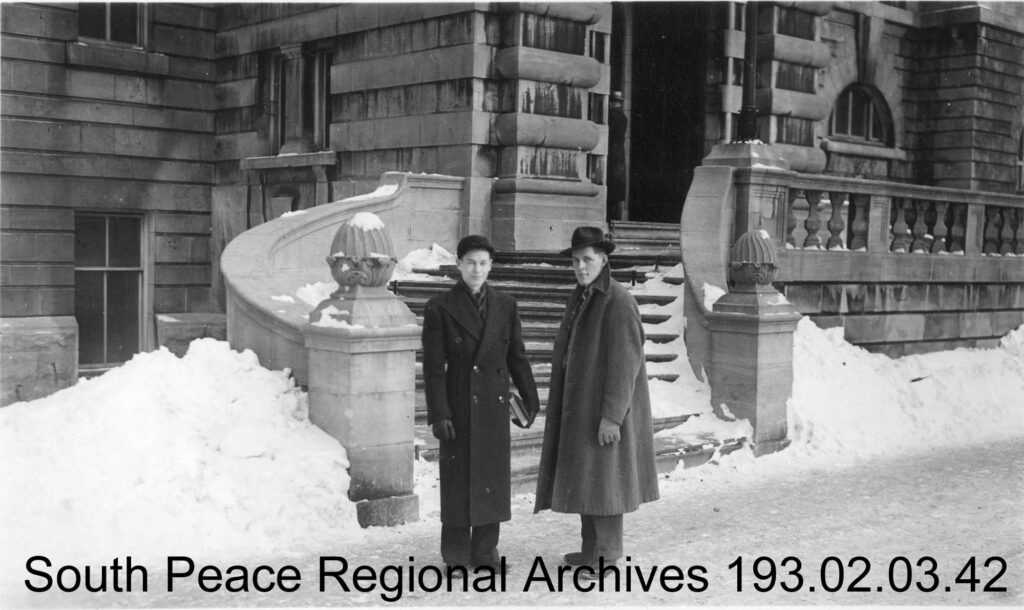Above: Kay Trelle and Rex Ford, another first year engineer from Douglas Hall, in front of the Engineering building at Queen’s University in December 1940. (SPRA 193.02.03.42)
Kay Trelle spent most of his career working for the aerospace industry in the United States. It was an interesting time of rapid growth in the aerospace industry, with the Cold War, the Cuban Missile Crisis, and the Space Race to land on the moon. For much of that time, he worked in secrecy for Boeing and Lockheed on projects such as the Polaris and Poseidon missiles, and the drone-carrying Boeing 747. While he recognized these accomplishments, his greatest thrill was always the challenge of solving the next problem. He returned to Canada in 1973 and retired to the Lake Saskatoon district in 1990.
Roy Kay Trelle was born at home to Herman and Beatrice Trelle on August 18, 1924, near the hamlet of Lake Saskatoon, Alberta. He started his education in a two-room school at Lake Saskatoon and finished high school in Calgary when his father was stationed there during World War II. When Kay turned 18 in 1942, he enlisted in the Canadian Air Force and trained with the Commonwealth Training Program in Vancouver, British Columbia. After the war, he traveled down to the United States to visit his family who had just moved to California. While he was there, his father was murdered by a disgruntled farm worker. Extending his visit to help his mother and 12 year-old brother during this crisis, Kay overstayed his visa and was drafted into the American Army. He served for two years with the occupation army in Japan. After his military service, he stayed on in California to attend the Cal-Aero Technical Institute. He graduated in 1950 with an Honors B.Sc. in Mechanical/Aeronautical Engineering, and received a special letter of recommendation from the president of the college. He married Dorothy Smith in 1949, and was divorced in the 1950s.
After graduation, Kay worked with Convair, an American aircraft manufacturing company. In 1952, he took a position as Design Group Supervisor with Hiller Helicopters in Palo Alto, California, where he directed engineers and draughtsmen on helicopter basic structures and mechanical design. He later went on to become a Consulting and Design Engineer for Cook Research Laboratories in Redwood City, California, in 1957.
In 1958 Kay was hired by Lockheed Aircraft Corporation, and three weeks later became part of a thirty-three member international team (called the Skunkworks) designing the Polaris Missile. He was working there during the time of the Cuban Missile Crisis in 1962. The Polaris Missile is still being used today on the Trident Submarine. Kay designed the release mechanism for the missile. He received a special commendation “for demonstrating outstanding imagination and design conception versatility resulting in substantial cost conservation benefits to the Polaris Missile Design Project.” When the Poseidon C3 Task Force was formed in February, 1964, Kay was included as a design specialist and lead engineer. He received his second commendation for his work on the Poseidon “design solutions for re-entry system installations, structures, and separation devices.” The letter states that Kay’s “valuable contribution will result in missile systems of high quality and will extend the success of LMSC in missile system programs.”
In 1966, Kay married his World War II sweetheart, Mae Morton, whom he had first met while in the Canadian Air Force Commonwealth Training Program in Vancouver. The couple had lost contact during the war and Mae assumed that Kay, like too many of his fellow soldiers, had died during the war. Kay re-established contact in 1965 and, after a separation of twenty-three years, they were married in 1966.
That same year, Kay moved from Lockheed to Boeing Aircraft Corporation in Seattle as a design specialist and lead engineer, with his primary responsibility “to develop an entirely new bomb suspension concept for tactical fighters.” The fighter program was being carried out in Germany and Kay took German language classes to facilitate his work. It was all for naught as the program was abandoned in November 1966.
This article was originally featured in the September 2020 issue of Telling Our Stories. Stay tuned for Part II on February 1.
